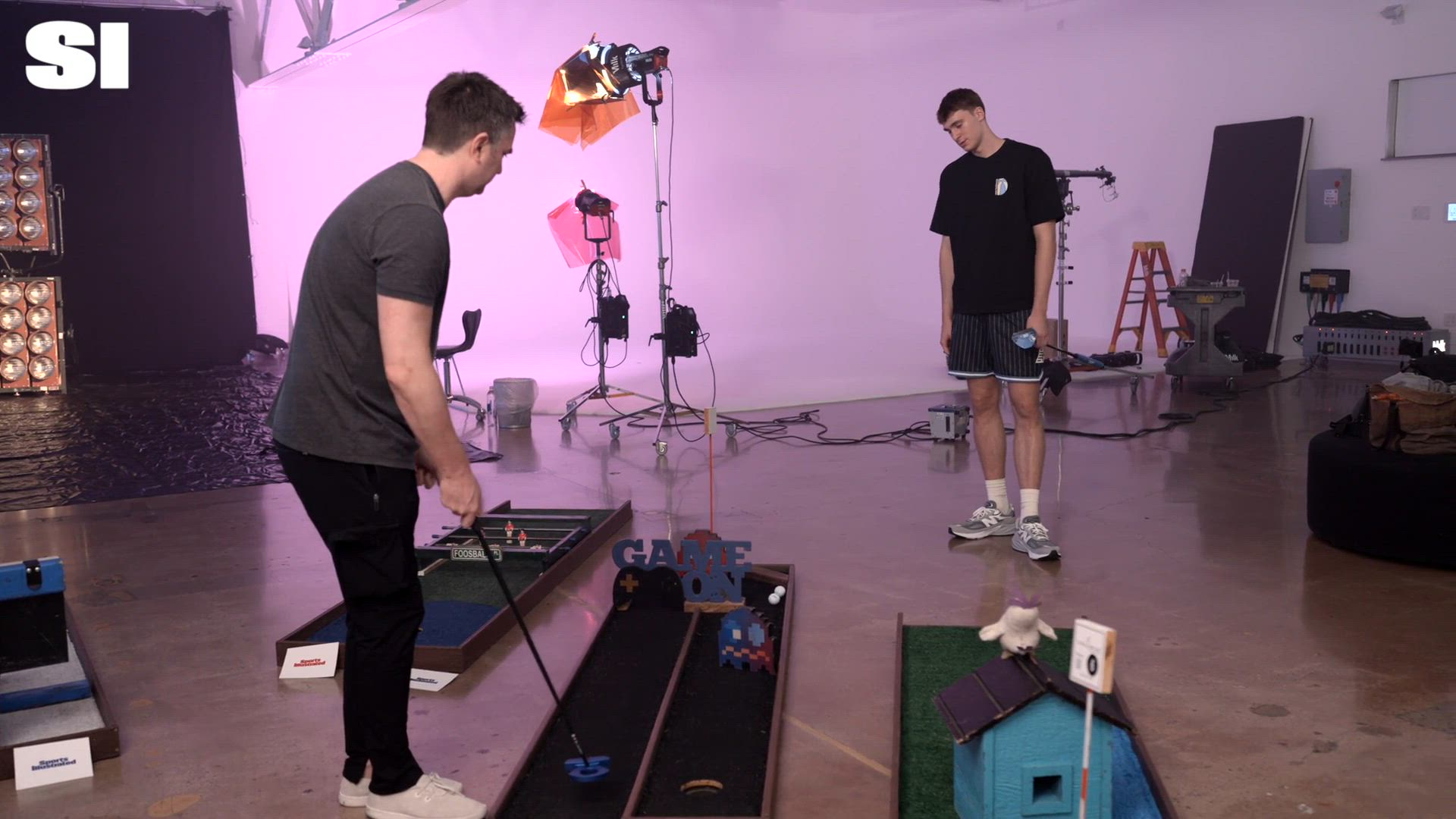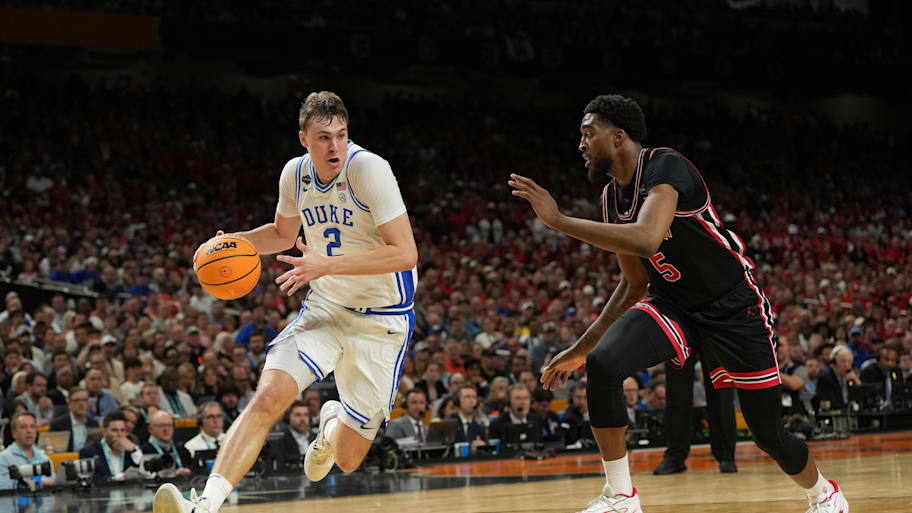Kelly Flagg has a saying, one her son, Cooper, repeated to reporters in New York this week: “If you’re the best player in the gym, you need to find a new gym.” It’s what drove Cooper Flagg to transfer from a small high school in northern Maine to Montverde Academy, a central Florida basketball powerhouse. It’s what motivated him to reclassify, to graduate after three years and enroll at Duke. And it’s what had him here, at the Barclays Center in Brooklyn poised to become the NBA’s youngest No. 1 draft pick since LeBron James.
On Wednesday, the Dallas Mavericks made that official, selecting Flagg first overall. There was no drama. Dallas has been zeroed in on Flagg since the team’s improbable lottery night win. In the days after, Flagg’s reps probed the Mavs to see if they might shop the pick. The response they got: Absolutely not. Whatever direction Dallas goes, Flagg would be part of it.
And why not? Flagg, 18, is the most celebrated U.S. prospect since James, a 6' 8", 221-pound forward with a 7-foot wingspan and 35 ½-inch vertical leap. He averaged 16.5 points per game in his senior year at Montverde, leading arguably the greatest high school basketball team ever assembled. At Duke, Flagg averaged 19.2 points per game, connecting on 38.5% of his three-pointers.
“He’s one of the best prospects we have had in a while,” says a high-ranking team executive. “Is he Wemby [2023 top pick Victor Wembanyama]? He doesn’t have quite that upside. But every few years you have guys who are absolute locks to go No. 1. Cooper is one of them. And all of them have turned out great.”
For years, as Flagg’s rise has been scrutinized, executives have asked a question: How? How did this kid from Newport, Maine—population 3,000 and change—develop into an elite prospect? How did someone whose early skill development largely happened in his driveway, battling his twin brother, Ace, become this kind of prodigious talent?
Andy Bedard asked himself the same thing. Bedard, a youth coach in southern Maine, had heard whispers of Flagg long before he started working with him. When he did, he was astounded by the talent. “In our world, you just don’t see somebody that young, that’s that tall and lanky, and he wasn’t like a baby giraffe,” Bedard says. As easy as it would be for Flagg to dominate physically, Bedard was struck by his desire to always make the smart play. “And I had a little bit of experience with our kids,” Bedard says. “But Cooper’s eight inches taller than them doing the same exact thing.”
There’s no denying Flagg’s genetic edge. Kelly was a 5' 10" guard who spent four years playing basketball at the University of Maine. Cooper’s father, Ralph, a 6' 9" big man who played at Eastern Maine Community College. Kelly thought her kids might gravitate toward basketball. Maybe even be good enough to play in college, to “get a full ride and not have to pay back school loans, and get a better start in life financially,” she said. Cooper’s natural talent, though, shocked even her.
Bedard was determined to cultivate it. Flagg had the size of a big man. Bedard wanted him to develop the skills of a guard. At practices, Bedard had Flagg working with the guards. On ballhandling. Stepback jumpers. Bedard’s son Kaden, an athletic defender, would pressure Flagg the length of the floor. It wasn’t long before Flagg could beat him.
“For a coach coaching against a team that presses you, he’s like blood pressure medicine,” Bedard says. “Just give him the ball and the game slows down. He finds space for everybody.”

Matt MacKenzie entered the picture around 2019. MacKenzie, an ex-Division III player, earned a reputation in Maine as a player development coach. MacKenzie’s training, he says, is “built on small-sided games and constraint-based learning. So I would constantly be putting constraints in place, or different challenges in place to try to take him out of his comfort zone and require him to have to make decisions, not just repetitive skill work.” Like Bedard, MacKenzie was startled by how quickly Flagg took to it.
“Let’s say it’s in pick-and-roll coverage, or coming off of a pin down,” MacKenzie says. “I could show him film on how he read the situation. He would immediately be able to say, ‘O.K., I recognize what I need to be doing, where I need to be looking.’ And then the next play out, you can see that his brain is just moving, and he’s always two steps ahead. He’s immediately applying that coaching in terms of what reads he needs to be looking for right away.
“His ability to just process and be two steps ahead of everybody else on the floor allows him to play a high-level brand of basketball. He’s just somebody who’s just so smart, and he makes everybody else around him better because he’s very rarely out of position, and he is usually making the right reads.”
Brian Scalabrine agrees. For years, Scalabrine, an ex-NBA forward and current analyst for NBC Sports Boston, had been running workouts for high school–aged kids. In 2019, MacKenzie brought Flagg down.
Scalabrine ran Flagg through everything. Eight-second shot clock, player can hold the ball for two seconds. “Try to speed them up,” Scalabrine says. “Gets sloppy real fast.” Flagg, says Scalabrine, was the best player on the floor. He showed him a Kyrie Irving drill, where players must make a dozen different versions of a layup. Right leg, left hand. Left leg, right hand. And so on. A total of 128 makes. A fast time for the drill is around three minutes. Flagg finished in just over two.
Scalabrine has another story: After a few workouts, he wanted to work with Flagg on pick-and-rolls. In his gym, there were no above-the-rim threats. So they traveled to New Hampshire, where they worked out with an athletic, 6'10" big. Quickly, says Scalabrine, Flagg “started running pick-and-roll, pocket pass, alley-oops, all that stuff. And he figured it out on the fly.”
Scalabrine was stunned. In 11 NBA seasons, Scalabrine played with some great teammates. Jason Kidd. Derrick Rose. Paul Pierce. Kevin Garnett. Flagg’s mind, says Scalabrine, was as sharp as all of them. “It takes people years to figure out the pick-and-roll, and this dude just figures it out on the fly,” Scalabrine says. “His learning curve as steep as anybody. You guys can compare him to whoever you want to compare him to, that’s fine. Like, LeBron James is an F1 racer. Cooper Flagg’s a Ferrari.”
It was Scalabrine who put Flagg on the radar of Duke coach Jon Scheyer. Like most, Scheyer had heard the name through reports from AAU tournaments and USA Basketball camps. His first look at Flagg came in 2023 at Peach Jam, an elite Nike-sponsored tournament. “I saw him in the back gym and he was spectacular, doing absolutely everything,” Scheyer says. “He almost had a triple-double in points, rebounds and blocks. It was incredible.”

Last summer, Scheyer traveled to Las Vegas for USA Basketball’s camp. Flagg, who had already committed to Duke, had been invited to scrimmage with the U.S. Olympic team. Most people remember Flagg’s second day, when he squared up and drilled a three over Anthony Davis on one possession and soared in for a putback dunk on the next.
Scheyer, though, remembers the day before. On that day he watched Flagg navigate a gym filled with great players. “There was a humility about him where he had great respect for everybody that he was on the court with,” Scheyer says. But as play picked up, he watched Flagg’s confidence grow. “By the end of the first day, I could see he was just like, ‘Man, I can do this,’ ” Scheyer says. “And then he came back on Day 2 and just put on a show.”
At Duke, Scheyer pushed Flagg to be assertive. “Sometimes he can defer to get others involved and to not want to step on toes when in reality, the team’s at its best when he’s being a killer all the time,” Scheyer says.” In a faster game, Scheyer pushed for Flagg to think quickly, to develop “the mentality of being ready to shoot.” On defense, he demanded accountability. “The positioning off the ball, fighting through screens, the communication, the talk on switches, just all the next-level stuff,” Scheyer says.
There was an adjustment period. Maybe a month or so. When Flagg came back from Christmas break, says Scheyer, “he was a killer.” He scored 48 points in his first two games after the holiday. Two games later, he had 42 against Notre Dame. Bedard recalls watching an early January game against Pittsburgh. In the second half, Flagg intercepted a pass below his own free throw line and in three dribbles drove the floor for a dunk.
“Watch how few dribbles and steps he steals to turn the angle to own his line and then go dunk on the guy,” Bedard says. “That’s what all the NBA guys love and talk to me about.”
Flagg’s coachability will stick with Scheyer. “It was never about holding his hand or coddling him,” Scheyer says. “And I think that breeds a certain toughness, a mental toughness in addition to obviously the physical toughness and everything he does on the floor. Flagg, Scheyer says, isn’t interested in the spectacular play. Just the right one.
“Cooper does not give a s--- about stats,” Scheyer says. “He does not care at all. He had great numbers this year. He would have had even better numbers if one, I played him the last six minutes of a lot of games because we had a lot of big wins. But then the second thing is down the stretch of games when we did have leads, he understands the importance of getting guys shots. It is just so rare to truly not have a guy that cares about stats.”
In Dallas, Flagg will step into a team with lofty expectations. Those around Flagg will admit—they were concerned that the lottery outcome would result in Flagg playing for a team in the early stage of a rebuild. “He just hates losing,” Kelly says. The Mavericks are stocked with top-end talent, led by Davis and Irving, who could return as early as midseason from an ACL injury. Early on, Flagg will be asked to play a supporting role for a winner. Which beats a bigger role on a loser.
To Flagg, it didn’t matter. He doesn’t think his competitive spirit is anything special. Normal, really, for players on a high level.
“I just know whenever I’m playing I want to do anything I can to the best of my ability to win every single game,” Flagg says. “I don’t understand why someone would ever do something and play a sport and not do everything they could to win. So that’s where I come from.”
And Dallas is where he is going.
More NBA draft on Sports Illustrated
This article was originally published on www.si.com as Cooper Flagg Selected No. 1 by Mavericks: How His Basketball Fit Translates to NBA.
